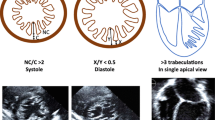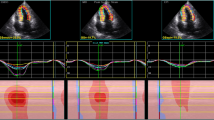Abstract
We aimed to detect residual cardiac dysfunction—if any—in children with recovered primary dilated cardiomyopathy (DCM) by using the left ventricular (LV) layer-specific myocardial strains. Fifty children with recovered primary DCM both clinically and echocardiographically were included as the patient group. Fifty healthy children of matched age and sex served as the control group. Echocardiographic evaluation was performed for all included children in the form of conventional echocardiography, tissue Doppler imaging (TDI), two-dimensional speckle tracking echocardiography (2D-STE), and LV layer-specific myocardial strain. Both LV systolic and diastolic functions measured by conventional echocardiography were similar in children with recovered DCM and the control group. There was a significant reduction in LV systolic and diastolic functions measured by TDI in the patient group. Moreover, there was a significant reduction of LV global longitudinal systolic strain (GLSS) by 2D-STE in children with recovered DCM. Interestingly, there was a significant reduction of LV layer-specific myocardial strain from endocardium to epicardium in children with recovered DCM compared to the healthy control. There was a significant positive correlation between different layer-specific myocardial strains and LV GLSS, LV ejection fraction, and LV peak systolic velocity. Left ventricular layer-specific myocardial strain can be a promising tool for early identifications of LV dysfunction in children with DCM. Subtle cardiac dysfunction is present in patients with recovered DCM, so long-term follow-up is recommended in these patients.



Similar content being viewed by others
References
Bakalakos A, Ritsatos K, Anastasakis A (2018) Current perspective on the diagnosis and management of dilated cardiomyopathy beyond heart failure: a cardiomyopathy clinic doctor’s point of view. Hellenic J Cardiol 59(5):254–261
Alvarez JA, Orav EJ, Wilkinson JD, Fleming LE, Lee DJ, Sleeper LA, Rusconi PG, Colan SD, Hsu DT, Canter CE, Webher SA, Cox GF, Jefferies JL, Towbin JA, Lipshultz SE, Pediatric Cardiomyopathy Registry Investigators (2011) Competing risks for death and cardiac transplantation in children with dilated cardiomyopathy: results from the Pediatric Cardiomyopathy Registry. Circulation 124:814–823
Lewis AB (1999) Late recovery of ventricular function in children with dilated cardiomyopathy. Am Heart J 138:334–338
Everitt MD, Sleeper LA, Lu M, Canter CE, Pahl E, Wilkinson JD, Addonizio LJ, Towbin JA, Rossano J, Singh RK, Lamour J, Webber SA, Colan SD, Margossian R, Kantor PF, Jefferies JL, Lipshultz SE (2014) Recovery of echocardiographic function in children with idiopathic dilated cardiomyopathy: results from the pediatric cardiomyopathy registry. J Am Coll Cardiol 63(14):1405–1413
Alexander PM, Daubeney PE, Nugent AW, Lee KJ, Turner C, Colan SD, Robertson T, Davis AM, Ramsay J, Justo R, Sholler GF, King I, Weintraub RG (2013) Long-term outcomes of dilated cardiomyopathy diagnosed during childhood: results from a national population-based study of childhood cardiomyopathy. Circulation 128:2039–2046
Torrent-Guasp F, Ballester M, Buckberg GD, Carreras F, Flotats A, Carrio I, Ferreira A, Samuels LE, Narula J (2001) Spatial orientation of the ventricular muscle band: physiologic contribution and surgical implications. J Thorac Cardiovasc Surg 122(2):389–392
Cong J, Wang Z, Jin H, Wang W, Gong K, Meng Y, Lee Y (2016) Quantitative evaluation of longitudinal strain in layer-specific myocardium during normal pregnancy in China. Cardiovasc Ultrasound 14:45
Adamu U, Schmitz F, Becker M, Kelm M, Hoffmann R (2009) Advanced speckle tracking echocardiography allowing a three myocardial layer-specific analysis of deformation parameters. Eur J Echocardiogr 10:303–308
Zhang Q, Fang F, Liang YJ, Xie JM, Wen YY, Yip GW, Lam YY, Chan JY, Fung JW, Yu CM (2011) A novel multi-layer approach of measuring myocardial strain and torsion by 2D speckle tracking imaging in normal subjects and patients with heart diseases. Int J Cardiol 147:32–37
Ozawa K, Funabashi N, Takaoka H, Kamata T, Kanaeda A, Saito M, Nomura F, Kobayashi Y (2015) Characteristic myocardial strain identified in hypertrophic cardiomyopathy subjects with preserved left ventricular ejection fraction using a novel multi-layer transthoracic echocardiography technique. Int J Cardiol 184:237–243
Bogdanović J, Ašanin M, Krljanac G, Lalić NM, Jotić A, Stanković S, Rajković N, Stošić L, Rasulić I, Milin J, Popović D, Bogdanović L, Lalić K (2019) Impact of acute hyperglycemia on layer-specific left ventricular strain in asymptomatic diabetic patients: an analysis based on two-dimensional speckle tracking echocardiography. Cardiovasc Diabetol 18:68
Eun LY, Lee Y (2018) Myocardial layer-specific strain analysis in children with mitochondrial disease. Yonsei Med J 59(1):128–134
Lai WW, Geva T, Shirali GS, Task Force of the Pediatric Council of the American Society of Echocardiography, Pediatric Council of the American Society of Echocardiography (2006) Guidelines and standards for performance of a pediatric echocardiogram: a report from the Task Force of the Pediatric Council of the American Society of Echocardiography. J Am Soc Echocardiogr 19(12):1413–1430
Amorim S, Campelo M, Martins E, Moura B, Sousa A, Pinho T, Silva-Cardoso J, Júlia Maciel M (2016) Prevalence, predictors and prognosis of ventricular reverse remodeling in idiopathic dilated cardiomyopathy. Rev Port Cardiol 35(5):253–260
Amorim S, Rodrigues J, CampeloM MouraB, Martins E, MacedoF S-C, Júlia Maciel M (2017) Left ventricular reverse remodeling in dilated cardiomyopathy maintained subclinical myocardial systolic and diastolic dysfunction. Int J Cardiovasc Imaging 33(5):605–613
Friedberg MK, Roche SL, Mohammed AF, Balasingam M, Atenafu EG, Kantor PF (2008) Left ventricular diastolic mechanical dyssynchrony and associated clinical outcomes in children with dilated cardiomyopathy. Circ Cardiovasc Imaging 1:50–57
Dujardin KS, Tei C, Yeo TC, Hodge DO, Rossi A, Seward JB (1998) Prognostic value of a Doppler index combining systolic and diastolic performance in idiopathic-dilated cardiomyopathy. Am J Cardiol 82(9):1071–1076
van Dalen BM, Kauer F, Vletter WB, Soliman OII, van der Zwaan HB, ten Cate FJ, Geleijnse ML (2010) Influence of cardiac shape on left ventricular twist. J Appl Physiol 108(1):146–151
Nesbitt GC, Mankad S (2009) Strain and strain rate imaging in cardiomyopathy. Echocardiography 26(3):337–344
Cong J, Fan T, Yang X, Squires JW, Cheng G, Zhang L (2015) Structural and functional changes in maternal left ventricle during pregnancy: a three dimensional speckle echocardiography study. Cardiovasc Ultrasound 13:6–13
Marwick TH (2006) Measurement of strain and strain rate by echocardiography: ready for prime time? J Am Coll Cardiol 47(7):1313–1327
Okada M, Tanaka H, Matsumoto K, Ryo K, Kawai H, Hirata K (2012) Subclinical myocardial dysfunction in patients with reverse-remodeled dilated cardiomyopathy. J Am Soc Echocardiogr 25(7):726–732
Shi J, Pan C, Kong D, Cheng L, Shu X (2016) Left ventricular longitudinal and circumferential layer-specific myocardial strains and their determinants in healthy subjects. Echocardiography 33(4):510–518
Leitman M, Lysiansky M, Lysyansky P, Friedman Z, Tyomkin V, Fuchs T, Adam D, Krakover R, Vered Z (2010) Circumferential and longitudinal strain in 3 myocardial layers in normal subjects and in patients with regional left ventricular dysfunction. J Am Soc Echocardiogr 23:64–70
Merlo M, Stolfo D, Anzini M, Negri F, Pinamonti B, Barbati G, Ramani F, Di Lenarda A, Sinagra G (2015) Persistent recovery of normal left ventricular function and dimension in idiopathic dilated cardiomyopathy during long term follow up: does real healing exist? JAHA 4:e001504
Moon J, Ko Y, Chung N, Ha J, Kang S, Choi E, Rim S (2009) Recovery and recurrence of left ventricular systolic dysfunction in patients with idiopathic dilated cardiomyopathy. Can J Cardiol 25(5):e147–e150
Basuray A, French B, Ky B, Vorovich E, Olt C, Sweitzer NK, Cappola TP, Fang GC (2014) Heart failure with recovered ejection fraction: clinical description, biomarkers, and outcomes. Circulation 129(23):2380–2387
Funding
None.
Author information
Authors and Affiliations
Corresponding author
Ethics declarations
Conflict of interest
All authors have no potential conflict of interest to disclose.
Ethical Approval
The study is in accordance with the ethical standards of institutional research committee and with the 1964 Helsinki declaration and its later amendments.
Additional information
Publisher's Note
Springer Nature remains neutral with regard to jurisdictional claims in published maps and institutional affiliations.
Rights and permissions
About this article
Cite this article
Maher, E., Elshehaby, W., El Amrousy, D. et al. Left Ventricular Layer-Specific Myocardial Strains in Children with Recovered Primary Dilated Cardiomyopathy: What Lies Beneath the Iceberg?. Pediatr Cardiol 41, 101–107 (2020). https://doi.org/10.1007/s00246-019-02228-7
Received:
Accepted:
Published:
Issue Date:
DOI: https://doi.org/10.1007/s00246-019-02228-7




